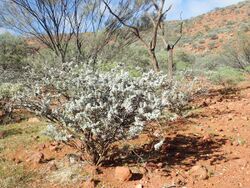Biology:Eremophila conferta
| Eremophila conferta | |
|---|---|

| |
| E. conferta growing near Mount Augustus | |
| Scientific classification | |
| Kingdom: | Plantae |
| Clade: | Tracheophytes |
| Clade: | Angiosperms |
| Clade: | Eudicots |
| Clade: | Asterids |
| Order: | Lamiales |
| Family: | Scrophulariaceae |
| Genus: | Eremophila |
| Species: | E. conferta
|
| Binomial name | |
| Eremophila conferta Chinnock[1]
| |
Eremophila conferta is a flowering plant in the figwort family, Scrophulariaceae and is endemic to a small area in the central west of Western Australia. It is a shrub with many tangled branches with leaves crowded near their ends and with mauve or purple flowers.
Description
Eremophila conferta is a shrub which usually grows to 1–1.5 m (3–5 ft) high with many tangled, dark brown branches which are often hidden, especially near their ends, by the leaves. The branches are covered with a layer of long, branched hairs. The leaves are arranged alternately, densely crowded and are covered with soft grey hairs. They are also elliptic to egg-shaped, mostly 12–25 mm (0.5–1 in) long, 6.5–13 mm (0.3–0.5 in) wide and have a distinct mid-vein on their lower surface.[2][3]
The flowers are borne singly in leaf axils on stalks 3–9 mm (0.1–0.4 in) long. There are 5 narrow, lance-shaped sepals, 7–13.5 mm (0.3–0.5 in) long which have a felt-like texture due to a covering of long, soft hairs. The petals are 18–28 mm (0.7–1 in) long and joined at their lower end to form a tube. The petal tube is purple, blue or lilac-coloured and white inside, with faint purple spots and is mostly glabrous. The 4 stamens are fully enclosed in the petal tube. Flowering occurs mostly from August to September and is followed by fruits which are oval-shaped, yellow-brown with a papery covering and are about 5.5–7.5 mm (0.2–0.3 in) long.[2][3]
Taxonomy and naming
Eremophila conferta was first formally described by Robert Chinnock in 2007 and the description was published in Eremophila and Allied Genera: A Monograph of the Plant Family Myoporaceae.[4] The type specimen was collected by Chinnock about 4 km (2 mi) west of the Mount Augustus homestead on the lower slopes of Mount Augustus.[2][4] The specific epithet (conferta) is a Latin word meaning "crowded"[5] referring to the leaves of this species.[2]
Distribution and habitat
This eremophila occurs between Kumarina and the Barlee Range in the Gascoyne biogeographic region[6] where it grows in stony soils on plains, and stony ridges.[3][7]
Conservation status
Eremophila conferta is classified as "not threatened" by the Government of Western Australia Department of Parks and Wildlife.[6]
Use in horticulture
This eremophila features soft grey foliage and showy flowers but is frost sensitive and will not tolerate humidity. It has been propagated by grafting onto Myoporum and grown in well-drained soil in a sunny position.[8]
References
- ↑ "Eremophila conferta". Australian Plant Census. https://biodiversity.org.au/nsl/services/apc-format/display/208487. Retrieved 10 April 2020.
- ↑ 2.0 2.1 2.2 2.3 Chinnock, R.J. (Bob) (2007). Eremophila and allied genera : a monograph of the plant family Myoporaceae (1st ed.). Dural, NSW: Rosenberg. pp. 507–508. ISBN 9781877058165.
- ↑ 3.0 3.1 3.2 Brown, Andrew; Buirchell, Bevan (2011). A field guide to the eremophilas of Western Australia (1st ed.). Hamilton Hill, W.A.: Simon Nevill Publications. p. 67. ISBN 9780980348156.
- ↑ 4.0 4.1 "Eremophila conferta". APNI. http://id.biodiversity.org.au/name/apni/208487. Retrieved 3 January 2016.
- ↑ Brown, Roland Wilbur (1956). The Composition of Scientific Words. Washington, D.C.: Smithsonian Institution Press. p. 227.
- ↑ 6.0 6.1 "Eremophila conferta". FloraBase. Western Australian Government Department of Parks and Wildlife. https://florabase.dpaw.wa.gov.au/browse/profile/17154.
- ↑ Paczkowska, Grazyna; Chapman, Alex R. (2000). The Western Australian flora : a descriptive catalogue. Perth: Wildflower Society of Western Australia. p. 334. ISBN 0646402439.
- ↑ Boschen, Norma; Goods, Maree; Wait, Russell (2008). Australia's eremophilas : changing gardens for a changing climate. Melbourne: Bloomings Books. p. 79. ISBN 9781876473655.
Wikidata ☰ Q15592358 entry
 |


